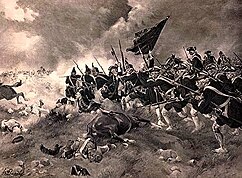Battle of Dettingen
While the Earl of Stair exercised operational control, the Allied army was nominally commanded by King George II, accompanied by his son the Duke of Cumberland.
The Pragmatic Sanction of 1713 allowed Maria Theresa to inherit the throne, but the ruling was challenged by Charles Albert of Bavaria, the closest male heir.
[9] France, Saxony and Bavaria occupied Habsburg territories in Bohemia, while Spain joined the war, hoping to regain possessions in Northern Italy lost to Austria in 1713.
By early 1742, Austria's position seemed desperate; Britain agreed to send a naval squadron to the Mediterranean and 17,000 troops to the Austrian Netherlands, under the Earl of Stair.
[11] The focus of the 1743 campaign switched to Germany; the Austrians defeated the Bavarians at Simbach and in mid-June, the Allied army arrived at Aschaffenburg, on the north bank of the River Main.
[14] The French position at Dettingen was extremely strong; De Gramont's infantry held a line anchored on the village, and running to the Spessart Heights, with the cavalry on level ground to their left.
Noailles instructed de Vallière to place his guns on the south bank of the Main, which allowed them to fire into the left flank of the Pragmatic army.
Ilton, commander of the Allied infantry, ordered the British and Hanoverian Foot Guards back to Aschaffenburg, while the remainder changed from column of march into four lines to attack the French position.
[25] The Allied cavalry performed woefully, failing to locate 23,000 men across their line of retreat, less than 13 km (8 mi) away, while many troopers were allegedly unable to control their horses.


